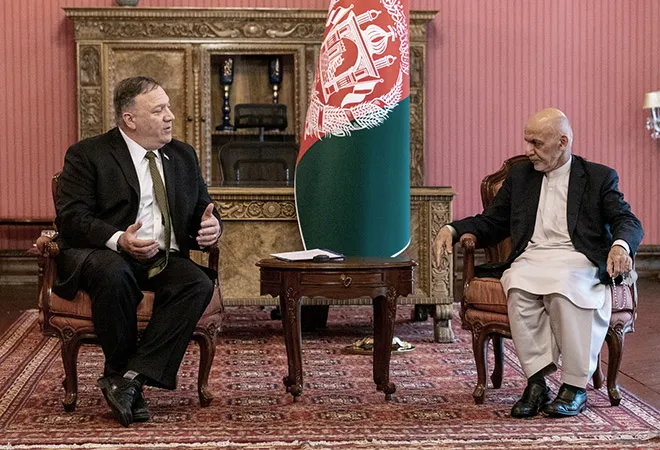Earlier this week, US Secretary of State Mike Pompeo’s visit to Afghanistan failed to bring the two main rival factions in the war-torn nation together, leading to the US decision to cut $1 billion aid. Expressing his “disappointment” bluntly, Mr Pompeo made it clear that the inability of Ashraf Ghani and Abdullah Abdullah to resolve their differences had “harmed US-Afghan relations and, sadly, dishonours those Afghan, Americans, and coalition partners who have sacrificed their lives and treasure in the struggle to build a new future for this country.”
Two parallel inauguration ceremonies earlier this month have ended up becoming the defining image of a divided and ruptured Afghanistan, even as the war torn nation has entered a new phase. Afghanistan remains a deeply divided nation at a time when the Donald Trump Administration has begun to withdraw its troops from Afghanistan as part of a deal it signed with the Taliban on February 29, ostensibly aimed at bringing peace to the country after 18 years of war. The US promised to reduce its troops from about 12,000 to 8,600 within 135 days of signing the agreement. This was a pre-condition laid down by the Taliban in return for its desire to start the intra-Afghan dialogue.
This intra-Afghan dialogue is the most crucial aspect of this so called peace process. The Taliban had long refused to sit with the government in Kabul, arguing that the actual power centre lies in Washington. Both the Hamid Karzai and Ashraf Ghani administrations had been trying to get the Taliban to talk, despite their apprehensions. Now the two sides have begun to sit across the table, but not without some initial turbulence. The Taliban had demanded the release of 5,000 prisoners as a confidence-building measure to initiate direct talks with the government and this was part of the US-Taliban arrangement as well.
But President Ghani refused to comply with this demand initially, arguing that this prerogative lay with Kabul, not Washington. After his formal inauguration as president earlier this week, he signed a decree to release 1,500 Taliban prisoners, as part of which all released Taliban prisoners will have to provide “a written guarantee to not return to the battlefield.” The Taliban rejected the move by claiming that they had handed a list of 5,000 prisoners to the US and would wait for all of them to be released before any talks could be started.
Both sides have been positioning themselves for talks and preparing for battle. Soon after the signing of the deal with the US, the Taliban broke the 11-day long ceasefire and launched 43 attacks on checkpoints belonging to Afghan forces in the Helmand province. The Taliban might be signalling their intent to continue fighting throughout the intra-Afghan talks, to improve their negotiating position. In response, the US launched air strikes against the Taliban to underscore their commitment to wider Afghan stability.
While de-escalation soon happened, the wider challenge to intra-Afghan negotiations comes from political disunity among the mainstream Afghan political parties. There were two Presidential inauguration ceremonies in Kabul with Mr Abdullah contesting Mr Ghani’s narrow victory in the September elections. This comes at a terrible time for Afghanistan, with intra-Afghan talks about to begin. The US wants the two sides to patch up and by making its backing of Mr Ghani clear, it is sending a message to Mr Abdullah. But, as various Afghan factions look to a post-US withdrawal landscape, they are making their own calculations. Factionalism is only going to grow, precisely when unity is sorely needed. And this would pose a serious challenge to Kabul when it sits down across the table with a resurgent Taliban.
For the US, this is a deal that allows it to get out of Afghanistan, a promise President Trump had made during his last election campaign. Despite his repeated pledges to end America's involvement in the war, he has gone back and forth on this. As part of his South Asia strategy, he ended up adding 4,000 US troops to the 8,900 American forces already deployed there. But with elections coming up, he clearly wants to get out, and this has the support of the American people. After investing more than $1 trillion and losing more than 2,400 lives, there is some truth to his assertions that the US has done its bit for Afghanistan; others should now shoulder more of the burden.
It is therefore strange to see the Indian commentariat react to the deal in Afghanistan by criticising the US. Washington can hardly be criticised for taking care of its own interests after investing in blood and treasure for 18 long years. Those who are complaining the most about the deal in India are also the ones who want India to continue with the status quo in its Afghanistan policy.
If India believes it has interests in Afghanistan that need to be preserved, then it should be doing much more than just berating Washington for its deal with the Taliban. Like all such deals, it is riddled with confusion and contradictions. But that’s the best that the US could come up with to protect its flanks. New Delhi should be thinking more about what its own options are in securing its flanks. So far, no satisfactory answer has been forthcoming.
This commentary originally appeared in The Business Standard
The views expressed above belong to the author(s). ORF research and analyses now available on Telegram! Click here to access our curated content — blogs, longforms and interviews.




 PREV
PREV


